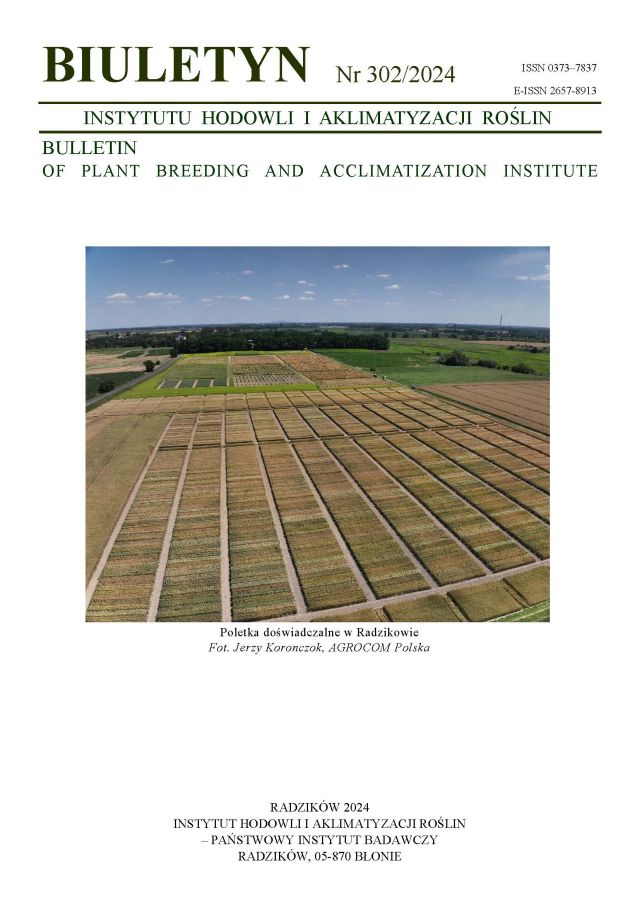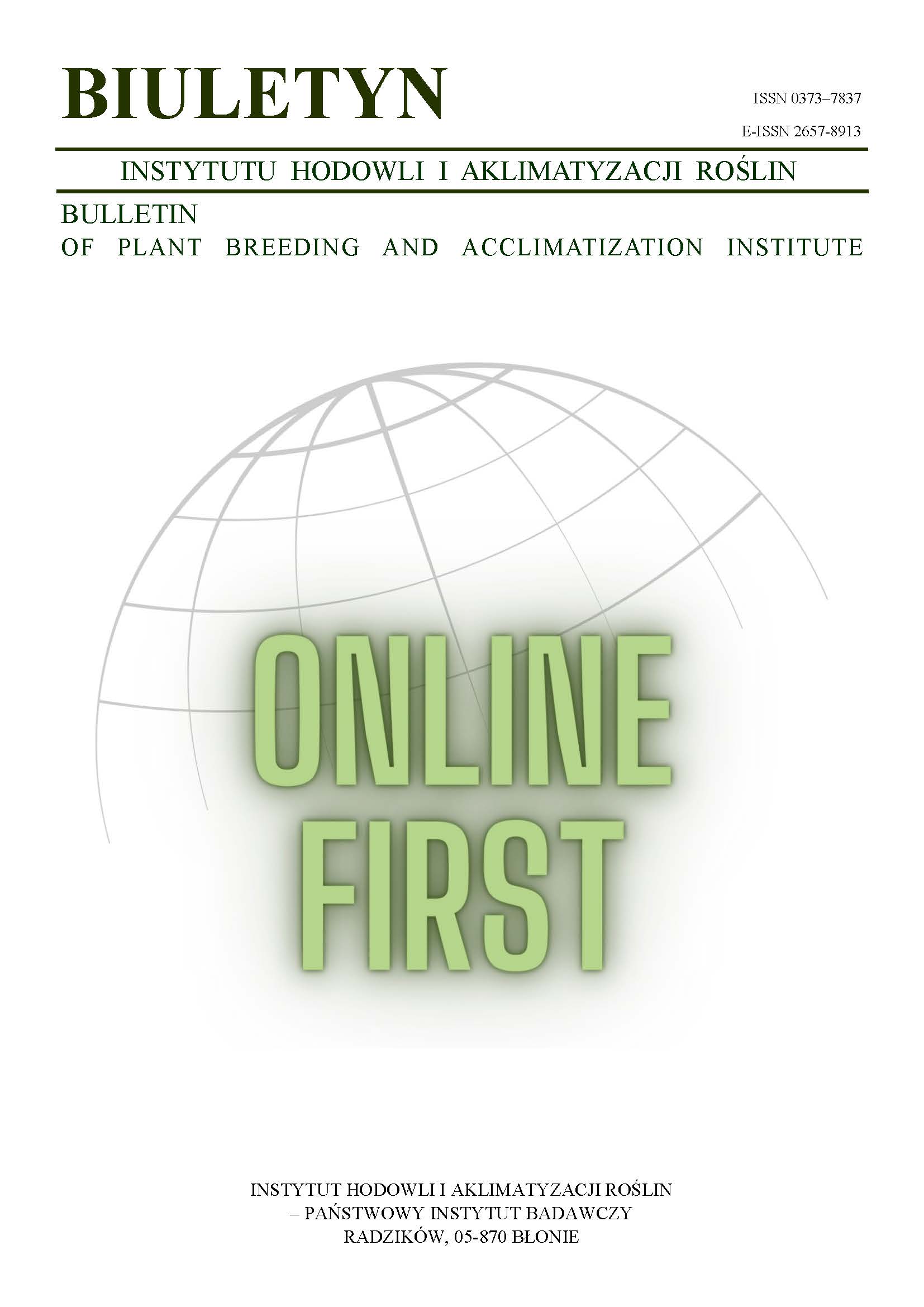Possibilities of using of introgressive hybridization in breeding of winter wheat T. aestivum L.
Part I. Utilization of the genetic systems of wheat T. aestivum L. for obtaining the F1-bridge hybrids
Józef Pilch
j.pilch@ihar.edu.plZakład Oceny Jakości i Metod Hodowli Zbóż, Instytut Hodowli i Aklimatyzacji Roślin w Krakowie (Poland)
Abstract
This paper presents the possibilities of utilization of introgressive hybridization for breeding requirements of winter wheat T. aestivum L. by the production of initial materials. The part I is concentrated on the ways of using of the wheat genetic systems for homoeologous / homologous pairing and crossability, aimed at obtaining the F1-bridge hybrids and breakage of the crossability barriers between T. aestivum L. and the species of genera Triticum, Hordeum, Secale, Aegilops, Agropyron, Lolium. Subsequently, the accessible genetic sources, methods of their use and their usefulness in introgressive hybridization were presented. Particular attention was paid to the genotypes of homoeologous pairing Ph1 ph1, ph1b ph1b and crossability kr1 kr1 kr2 kr2.
Keywords:
Triticum aestivum L., F1-bridge hybrids, genetic systems, introgressive hybridizationReferences
Anderson E. 1949. Introgressive hybridization. London, Chapman and Hall.
DOI: https://doi.org/10.5962/bhl.title.4553
Google Scholar
Chapman V., Miller T. E. 1981. The location of a gene affecting meiotic chromosome pairing at low temperature in Triticum aestivum. Z. Pflanzenzüchtg. 86: 50 — 55.
Google Scholar
Chen P.D.,Tsujimoto H., Gill B.S. 1994. Transfer of Ph I genes promoting homoeologous pairing from Triticum speltoides to common wheat. Theor. Appl. Genet. 88: 97 — 101.
DOI: https://doi.org/10.1007/BF00222400
Google Scholar
Dhaliwal H. S. 1977. The Ph gene and the origin of tetraploid wheats. Genetica, 47, 3: 177 — 182.
DOI: https://doi.org/10.1007/BF00123238
Google Scholar
Dover G. A., Riley R. 1972. Prevention of pairing of homoeologous meiotic chromosomes of wheat by an activity of supernumerary chromosomes of Aegilops. Nature 240: 159 — 161.
DOI: https://doi.org/10.1038/240159a0
Google Scholar
Driscoll C. 1972. Genetic suppression of homoeologous pairing in hexaploid wheat. Can. J. Genet. Cytol. 14: 39 — 42.
DOI: https://doi.org/10.1139/g72-004
Google Scholar
Driscoll C. J., Jensen N. F. 1963. A genetic method for detecting induced intergeneric translocations. Genetics 48: 459 — 468.
DOI: https://doi.org/10.1093/genetics/48.4.459
Google Scholar
Dvorak J., Chen K. C., Giorgi B. 1984. The C-banding pattern of a Ph-mutant of durum wheat. Can. J. Genet. Cytol. 26: 360 — 363.
DOI: https://doi.org/10.1139/g84-056
Google Scholar
Evans G. M., Macefield A. J. 1973. The effect of B chromosomes on homoeologous pairing in species hybrids. 1. Lolium temulentum × Lolium perenne. Chromosoma 41: 63 — 73.
DOI: https://doi.org/10.1007/BF00284074
Google Scholar
Fedak G., Jui P.Y. 1982. Chromosomes of Chinese Spring wheat carrying genes for crossability with Betzes barley. Can. J.Genet. Cytol. 24: 227 — 233.
DOI: https://doi.org/10.1139/g82-024
Google Scholar
Feldman M. 1966. The effect of chromosomes 5B, 5D and 5A on chromosomal pairing in Triticum aestivum. Proc. Nat. Acad Sci. USA 55: 1447 — 1453.
DOI: https://doi.org/10.1073/pnas.55.6.1447
Google Scholar
Giorgi B. 1978. A homoeologous pairing mutant isolated in T. durum cv. “Cappelli”. Mutat. Breed. Newsl. 11: 4 — 5.
Google Scholar
Hayter A. M., Riley R. 1967. Duplicate genetic activities affecting meiotic chromosome pairing at low temperatures in Triticum. Nature 216, No. 5119: 1028 — 1029.
DOI: https://doi.org/10.1038/2161028a0
Google Scholar
Kimber G. 1967. The incorporation of the resistance of Aegilops ventricosa to Cercosporella herpotrichoides into Triticum aestivum. J. Agric. Sci. Camb. 68: 373 — 376.
DOI: https://doi.org/10.1017/S0021859600012879
Google Scholar
Kluska T., Pilch J. 1995. Krzyżowanie odmian i rodów pszenicy heksaploidalnej Triticum aestivum L. z żytem diploidalnym Secale cereale L. i uzyskanie form pierwotnych pszenżyta oktoploidalnego. Biul. IHAR 194: 53 — 61.
Google Scholar
Krolow K. D. 1970. Untersuchungen über die Kreuzbarkeit zwischen Weizen und Roggen. Z. Pflanzenzüchtg. 64: 44 — 72.
Google Scholar
Lein A. 1943. Die genetische Grundlage der Kreuzbarkeit zwischen Weizen und Roggen. Z. Vererbungsl. 81: 28 — 61.
DOI: https://doi.org/10.1007/BF01847441
Google Scholar
Lelley T. 1976. The effect of supernumerary chromosomes of rye on homoeologous pairing in hexaploid wheat. Z. Pflanzenzüchtg. 77: 281 — 285.
Google Scholar
Luo M. C., Yen C., Yang J. L. 1992. Crossability percentage of bread wheat landraces from Sichuan province China with rye. Euphytica 61: 1 — 7.
DOI: https://doi.org/10.1007/BF00035540
Google Scholar
Luo M. C., Yen C., Yang J. L. 1993. Crossability percentages of bread wheat landraces from Shaanxi and Henan provinces, China with rye. Euphytica 67: 1 — 8.
DOI: https://doi.org/10.1007/BF00022718
Google Scholar
Mello-Sampayo T. 1971. Genetic regulation of meiotic chromosome pairing by chromosome 3D of Triticum aestivum. Nature New Biol. 230: 22 — 23.
DOI: https://doi.org/10.1038/newbio230022a0
Google Scholar
Pilch J. 1996. Performance of interspecific and intergeneric hybrids of Triticum aestivum L for wheat improvement. Part I. Performance of winter generations F3 — F5 of T. aestivum L. with Triticum {2x, 4x}, Aegilops {2x}, and Elymus {4x} species in respect of some characters of spike. Plant Breed. Seed Sci., vol. 40, No. 3/4: 73 — 62.
Google Scholar
Pilch J., Głowacz E. 1997. Międzygatunkowe i międzyrodzajowe krzyżowania jako sposób ulepszania cech kłosa w hodowli pszenicy heksaploidalnej Triticum aestivum L. Biul. IHAR 204: 15 — 31.
Google Scholar
Pilch J. 2001. Crossability effects of spring wheat (Triticum durum Desf.) with rye (Secale cereale L.) genotypes. Plant Breeding Seed Sci. vol. 45. No. 2: 33 — 43.
Google Scholar
Pilch J. 2002 a. Wartość technologiczna introgresywnych form pszenicy ozimej (Triticum aestivum L.). Biul. IHAR 223/224: 95 — 109.
Google Scholar
Pilch J. 2002 b. Transformacje cech kłosa pszenicy Triticum aestivum L. z wykorzystaniem międzygatunkowej i międzyrodzajowej hybrydyzacji.. Zesz. Probl. Post. Nauk Rol., zesz. 488: 207 — 213.
Google Scholar
Pilch J. 2004. Wykorzystanie hybrydyzacji introgresywnej w podwyższaniu wartości technologicznej ziarna pszenicy ozimej Triticum aestivum L. Pam. Puł. 135: 247 — 257.
Google Scholar
Qu L. J., Foote T. N., Roberts M. A., Money T. A., Aragon-Alcaide L., Snape J. W., Moore G. 1998. A simple PCR-based method for scoring the ph1b deletion in wheat. Theor. Appl. Genet. 96: 376 — 375.
DOI: https://doi.org/10.1007/s001220050751
Google Scholar
Riley R., Chapman V. 1958. Genetic control of the cytologically diploid behavior of hexaploid wheat. Nature 182: 713 — 715.
DOI: https://doi.org/10.1038/182713a0
Google Scholar
Riley R. 1960. The diploidization of polyploid wheat. Heredity 15: 407 — 429.
DOI: https://doi.org/10.1038/hdy.1960.106
Google Scholar
Riley R. 1966. The genetic regulation of meiotic behavior in wheat and its relatives. In: MacKay J. (ed.) Proc. 2nd Int. Wheat Genet. Symp. Hereditas 2 (Suppl): 395 — 408.
Google Scholar
Riley R., Chapman V. 1967. The inheritance in wheat of crossability with rye. Genet. Res. 9: 259 — 267.
DOI: https://doi.org/10.1017/S0016672300010569
Google Scholar
Riley R., Kimber G., Chapman V. 1961. Origin of genetic control of diploid-like behavior of polyploid wheat. J. Hered. 52: 22 — 25.
DOI: https://doi.org/10.1093/oxfordjournals.jhered.a107015
Google Scholar
Riley R., Chapman V., Miller T. E. 1973. The determination of meiotic chromosome pairing. Proc. 4th Int. Wheat Genet. Symp. Univ. Columbia. MO.: 731 — 738.
Google Scholar
Romero C., Lacadena J. R. 1980. Interaction between rye B-chromosomes and wheat genetic systems controlling homoeologous pairing. Chromosom (Berl.) 80: 33 — 48.
DOI: https://doi.org/10.1007/BF00327564
Google Scholar
Sears E. R. 1954. The systematic, cytology and genetics of wheat. Res. Bull. Mis. Agric. Exptl. Stat. 572: 1 — 58.
Google Scholar
Sears E. R. 1956. The transfer of leaf-rust resistance from Aegilops umbellulata to wheat. Brookhaven Symposia in Biology 9: 1 — 22.
Google Scholar
Sears E. R. 1976. Genetic control of chromosome pairing in wheat. Ann. Rev. Genet.10: 31 — 51.
DOI: https://doi.org/10.1146/annurev.ge.10.120176.000335
Google Scholar
Sears E. R. 1977. An induced mutant with homoeologous pairing in common wheat. Can. J. Genet. Cytol. 19: 585 — 593.
DOI: https://doi.org/10.1139/g77-063
Google Scholar
Sears E. R. 1981. Transfer of alien genetic material to wheat. In: Evans IT, Peacock WI (eds.) Wheat science — today and tomorrow. Cambridge Univ. Press.UK: 75 — 89.
Google Scholar
Sears E. R. 1982. A wheat mutation conditioning an intermediate level of homoeologous chromosome pairing. Can. J. Genet. Cytol. 24: 715 — 719.
DOI: https://doi.org/10.1139/g82-076
Google Scholar
Sears E. R. 1984. Mutations in wheat that raise the level of meiotic chromosome pairing. In: Gene manipulation in plant improvement. Stadler Genet. Symp., 16th. Plenum Press, New York (Ed. Gustafson J. P.): 295 — 300.
DOI: https://doi.org/10.1007/978-1-4613-2429-4_11
Google Scholar
Segal G., Liu B., Vega J. M., Abbo S., Rodova M., Feldman M. 1977. Identification of a chromosome-specific probe that maps within the Ph1 deletions in common and durum wheat. Theor. Appl. Genet. 94: 968 — 970.
DOI: https://doi.org/10.1007/s001220050502
Google Scholar
Xie D. X., Devos K. M., Moore G., Gale M. D. 1993. RFLP-based genetic maps of the homoeologous group 5 chromosomes of bread wheat (Triticum aestivum L.). Theor. Appl. Genet. 87: 70 — 74.
DOI: https://doi.org/10.1007/BF00223747
Google Scholar
Authors
Józef Pilchj.pilch@ihar.edu.pl
Zakład Oceny Jakości i Metod Hodowli Zbóż, Instytut Hodowli i Aklimatyzacji Roślin w Krakowie Poland
Statistics
Abstract views: 62PDF downloads: 28
License
Copyright (c) 2005 Józef Pilch

This work is licensed under a Creative Commons Attribution-ShareAlike 4.0 International License.
Upon submitting the article, the Authors grant the Publisher a non-exclusive and free license to use the article for an indefinite period of time throughout the world in the following fields of use:
- Production and reproduction of copies of the article using a specific technique, including printing and digital technology.
- Placing on the market, lending or renting the original or copies of the article.
- Public performance, exhibition, display, reproduction, broadcasting and re-broadcasting, as well as making the article publicly available in such a way that everyone can access it at a place and time of their choice.
- Including the article in a collective work.
- Uploading an article in electronic form to electronic platforms or otherwise introducing an article in electronic form to the Internet or other network.
- Dissemination of the article in electronic form on the Internet or other network, in collective work as well as independently.
- Making the article available in an electronic version in such a way that everyone can access it at a place and time of their choice, in particular via the Internet.
Authors by sending a request for publication:
- They consent to the publication of the article in the journal,
- They agree to give the publication a DOI (Digital Object Identifier),
- They undertake to comply with the publishing house's code of ethics in accordance with the guidelines of the Committee on Publication Ethics (COPE), (http://ihar.edu.pl/biblioteka_i_wydawnictwa.php),
- They consent to the articles being made available in electronic form under the CC BY-SA 4.0 license, in open access,
- They agree to send article metadata to commercial and non-commercial journal indexing databases.
Most read articles by the same author(s)
- Józef Pilch, Effectiveness of HMW — glutenin gene Glu-1 introgressions in bread-making quality improvement of cereals — a review , Bulletin of Plant Breeding and Acclimatization Institute: No. 243 (2007): Regular issue
- Józef Pilch, Introgressions of genes from taxonomically related species in improvement of wheat Triticum aestivum L. and other cultivated plants , Bulletin of Plant Breeding and Acclimatization Institute: No. 260/261 (2011): Regular issue
- Józef Pilch, Using genes of diploid, tetraploid and hexaploid species of wheat Triticum L. in the varieties of hexaploid wheat Triticum aestivum L. , Bulletin of Plant Breeding and Acclimatization Institute: No. 262 (2011): Regular issue
- Józef Pilch, Genetic possibilities of grain quality improvement of winter wheat Triticum aestivum L. in the effect of introgressive hybridization with Triticum durum Desf. , Bulletin of Plant Breeding and Acclimatization Institute: No. 236 (2005): Regular issue
- Józef Pilch, Effect of the A and B genomes Triticum durum Desf. on bread-making quality in winter wheat Triticum aestivum L. , Bulletin of Plant Breeding and Acclimatization Institute: No. 230 (2003): Regular issue
- Józef Pilch, Genetic determination of the morphological traits of a spike of wheat (Triticum aestivum L.) , Bulletin of Plant Breeding and Acclimatization Institute: No. 228 (2003): Regular issue
- Józef Pilch, Possibilities of using of introgressive hybridization in breeding of winter wheat T. aestivum L. , Bulletin of Plant Breeding and Acclimatization Institute: No. 235 (2005): Regular issue














